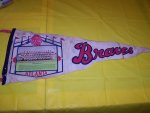flyingt
Senior Member
I have found a penant from the 1967 Braves. It has a inlaid picture with Phil Neikro on it. Does anyone have any idea on how to value it ? also If it is worth some money I want to get it cleaned up. I don't think the local dry cleaner would do. any ideas?
I am gonna build a custom case and display it in the man room either way. It's kinda cool.
I am gonna build a custom case and display it in the man room either way. It's kinda cool.




